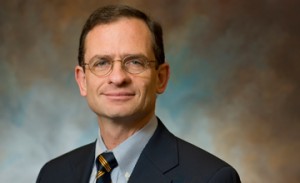Lafayette prevails.
That was the message College President Daniel H. Weiss gave to a group of about 100 gathered in the Oechsle Hall auditorium to hear “The Plan for Lafayette.” In his presentation and the ensuing question-and-answer session June 6 during Reunion, Weiss spoke frankly about the challenges the College has had to contend with during the past academic year, those that await in the future, and how the school is confronting them head on.

President Daniel Weiss
The most formidable of those challenges is the economic earthquake that has shaken the country and its financial sector for the past year. Like many other colleges and universities, Lafayette suffered deep losses: about $200 million, or 25 percent of its endowment. Giving also is down, Weiss noted.
Those losses have presented Lafayette and other schools with new challenges, as the demand for financial aid has increased, not only among prospective students but also among students already enrolled at the school as their family’s ability to pay tuition has been compromised – at a very time when the well of financial aid is not as deep as it was.
“I think we’re seeing a paradigm shift in the way higher education is financed in this country,” said Weiss. “We cannot raise tuition at the rate we historically have.”
Despite this, the College has boosted funding for financial aid by 8 percent as part of its commitment to Lafayette families, said Weiss.
As the families of high school seniors tighten their belts and review their options for college, Lafayette is reaching out to high school guidance counselors to boost the College’s profile so that it will continue to attract the best and brightest students, from new areas as well as familiar ones. It also is remaining focused on its strong externship and internship programs so that more students gain real-world job experience while they pursue their studies.
These are all selling points for the education Lafayette provides, but sometimes they can be forgotten by income-pinched families whose attention is seized solely by the differences in tuition between a high-caliber private college like Lafayette and public universities. There has been an “explosion of applications” to public universities and small decreases at Lafayette and peer institutions such as Bucknell, Colgate, and Holy Cross, Weiss reported. Yet the value of a Lafayette education goes far deeper than the cost of tuition or the degree a student earns; it is what Weiss called “a lifetime investment.”
“We need to be clear that we can make that case,” said Weiss, who noted that Robert Massa, the incoming vice president for communications and a nationally recognized expert in enrollment management, will be charged with articulating and promoting the College’s competitive advantages.
Much of that case is being made by the triumphs of Lafayette’s own academic and extracurricular programs. Weiss noted that The Wall Street Journal on June 4 reported on research by economics professors Chris Ruebeck and Susan Averett on how multiracial teens identify themselves. Wendy Hill, provost and Rappolt Professor of Neuroscience, not long ago received coverage from ABC, CNN, U.S. News and World Report, the Associated Press, the BBC, and other national and international media for her research with students on the physiology of kissing. The forensics (speech and debate) team won the national championship for its division last month, besting teams from schools such as NYU, UCLA, and Florida State.
Weiss also reported that among the six fraternities and six sororities on campus, three fraternities are in disciplinary trouble. Next year, a panel will consider Greek issues such as the lower grade-point average and higher incidence of disciplinary problems among fraternity members compared to the rest of the campus.
“I don’t believe any organization has a lifetime right to be here”—all must contribute, said Weiss.
Other topics raised by Weiss in his speech and answers to alumni questions included:
- The tragic losses of Chris Reynoso ’11, Jeremy Saxe ’09, and Adam Lambert ’08;
- The student-driven push toward environmentally sustainable practices on campus, which will be reflected in new building construction;
- The College’s reaccreditation;
- The strong student interest in community service, earning recognition in the form of awards and honors for the Landis Community Outreach Center;
- The national problem of binge drinking on college campuses;
- The College’s ongoing commitment to bring international students to campus and integrate them.
Amid challenges and triumphs, Lafayette continues to attract high-quality applicants and faculty. Despite the small drop in applications, the academic profile of the Class of 2013 is about the same as that of the prior class, Weiss said. Because financially devastated institutions such as Harvard, Yale, and Dartmouth are not hiring faculty, deepening the applicant pool with great candidates, Lafayette’s initiative to boost the size of the faculty (without enlarging the student body) is bringing in exceptionally qualified professors with the potential to transform the College, according to Weiss.
“Exciting things are happening here right now, and they’ll continue to happen,” he said. “It’s an exciting time to be at the College.”
